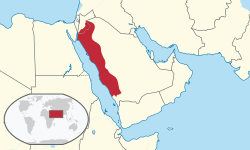
Back مملكة الحجاز Arabic مملكة الحجاز ARZ Reinu del Hiyaz AST Hicaz krallığı Azerbaijani حیجاز کراللیغی AZB Хижәз короллеге Bashkir Хіджаз (каралеўства) Byelorussian Кралство Хиджаз Bulgarian হেজাজ রাজতন্ত্র Bengali/Bangla Haiximites del Hijaz Catalan
Hashemite Kingdom of Hejaz المملكة الحجازية الهاشمية Al-Mamlakah al-Ḥijāzyah Al-Hāshimīyah | |||||||||||
|---|---|---|---|---|---|---|---|---|---|---|---|
| 1916–1925 | |||||||||||
Coat of arms
(1920–1925) | |||||||||||
 Kingdom of Hejaz (red) within modern-day Saudi Arabia and Jordan | |||||||||||
| Capital | Mecca (1916–1924) Jeddah (1924–1925)[1] | ||||||||||
| Common languages | Arabic | ||||||||||
| Ethnic groups | Arabs | ||||||||||
| Religion | Sunni Islam | ||||||||||
| Demonym(s) | Hejazi | ||||||||||
| Government | Absolute monarchy | ||||||||||
| King | |||||||||||
• 1916–1924 | Hussein bin Ali | ||||||||||
• 1924–1925 | Ali bin Hussein | ||||||||||
| Historical era | World War I Interwar period | ||||||||||
| 10 June 1916 | |||||||||||
| 10 August 1920 | |||||||||||
• Foundation of the Sharifian Caliphate | 3 March 1924 | ||||||||||
| 19 December 1925 | |||||||||||
• Abdulaziz crowned King of Hejaz | 8 January 1926 | ||||||||||
| Population | |||||||||||
• 1920 | 850,000 | ||||||||||
• 1925[1] | 900,000 | ||||||||||
| Currency | Hejazi riyal | ||||||||||
| |||||||||||
| Today part of | Saudi Arabia Jordan | ||||||||||
The Hashemite Kingdom of Hejaz (Arabic: المملكة الحجازية الهاشمية, Al-Mamlakah al-Ḥijāziyyah Al-Hāshimiyyah) was a state in the Hejaz region of Western Asia that included the western portion of the Arabian Peninsula that was ruled by the Hashemite dynasty. It was self-proclaimed as a kingdom in June 1916 during the First World War, to be independent from the Ottoman Empire, on the basis of an alliance with the British Empire to drive the Ottoman Army from the Arabian Peninsula during the Arab Revolt.
The British government had promised Hussein bin Ali, King of Hejaz, a single independent Arab state that would include, in addition to the Hejaz region, modern-day Jordan, Iraq, and most of Syria, with the fate of the Palestine region (today's Israel and Palestine) being mentioned in more ambiguous terms. However, at the end of the First World War, the Treaty of Versailles turned Syria into a French League of Nations mandate and Iraq, Mandate Palestine and Transjordan into British mandates. Hashemite princes were installed as monarchs under the British mandates in Transjordan and Iraq; this became known as the Sharifian solution.
Relations with the British Empire further deteriorated when Jews were allowed to move to Palestine. Hussein refused to ratify the 1919 Treaty of Versailles, and, in response to a 1921 British proposal to sign a treaty accepting the Mandate system, stated that he could not be expected to "affix his name to a document assigning Palestine to the Zionists and Syria to foreigners".[2] A further British attempt to reach a treaty failed in 1923–24 and negotiations were suspended in March 1924;[3] within six months the British withdrew their support in favour of their central Arabian ally Ibn Saud, who proceeded to conquer Hussein's kingdom.[4][5]
On 23 September 1932, the Kingdom of Hejaz and Nejd was unified with the other Saudi dominions, creating the unified Kingdom of Saudi Arabia.[6][7]
- ^ a b Ben Chaoon. "Saudi Arabia". WorldStatesmen.org. Ben M. Cahoon. Retrieved 9 April 2021.
- ^ Mousa 1978, p. 185.
- ^ Huneidi 2001, pp. 71–72.
- ^ Huneidi 2001, p. 72.
- ^ Mai Yamani (13 October 2009), Cradle of Islam: the Hijaz and the quest for an Arabian identity (Pbk. ed.), I.B. Tauris (published 2009), ISBN 978-1-84511-824-2
- ^ Madawi Al Rasheed. A History of Saudi Arabia. Cambridge, England, UK: Cambridge University Press, 2002.
- ^ A Brief overview of Hejaz – Hejaz history
© MMXXIII Rich X Search. We shall prevail. All rights reserved. Rich X Search



